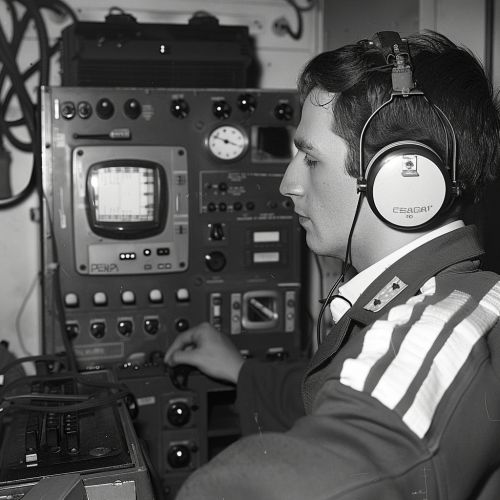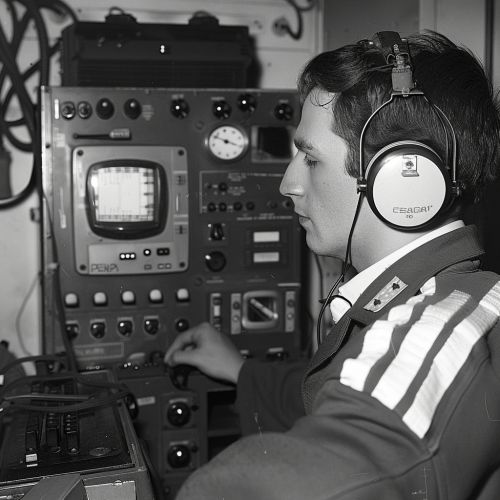Radio direction finding
Introduction
Radio direction finding (RDF) is a technique used to determine the direction from which a received radio signal was transmitted. This method is crucial in various fields, including navigation, search and rescue, and military applications. RDF systems typically consist of a radio receiver and a directional antenna, which together allow the operator to ascertain the direction of the incoming signal. The principles of RDF are deeply rooted in the physics of electromagnetic waves and the technology of radio communication.
Historical Background
The concept of radio direction finding dates back to the early 20th century. One of the earliest applications was in maritime navigation, where RDF was used to help ships determine their position relative to known radio beacons. During World War I and World War II, RDF technology advanced significantly, driven by the need for accurate location of enemy transmitters. The development of more sophisticated antennas and receivers allowed for greater precision and reliability.
Principles of Operation
Radio direction finding operates on the principle that a directional antenna can receive signals more strongly from certain directions than others. By rotating the antenna and measuring the signal strength, the direction of the source can be determined. There are several types of directional antennas used in RDF, including loop antennas, Adcock antennas, and Yagi-Uda antennas.
Loop Antennas
Loop antennas are among the simplest and most common types used in RDF. They consist of a loop of wire or conductive material that receives the magnetic component of the electromagnetic wave. The direction of the incoming signal can be determined by rotating the loop and finding the position where the signal strength is at its maximum or minimum.
Adcock Antennas
Adcock antennas are an improvement over loop antennas, designed to eliminate the ambiguity in direction finding. They consist of two pairs of vertical dipoles arranged in a cross pattern. By comparing the phase difference of the signals received by each pair, the direction of the incoming signal can be determined with greater accuracy.
Yagi-Uda Antennas
Yagi-Uda antennas, commonly known as Yagi antennas, are highly directional and consist of multiple elements arranged in a line. These antennas are particularly useful for high-frequency RDF applications, such as locating VHF and UHF transmitters.
Techniques and Methods
Various techniques and methods are employed in radio direction finding to enhance accuracy and reliability. These include the Watson-Watt method, Doppler RDF, and time difference of arrival (TDOA) techniques.
Watson-Watt Method
The Watson-Watt method, also known as the goniometer method, uses a pair of crossed loop antennas and a goniometer to measure the phase difference between the received signals. This method provides a quick and accurate determination of the signal direction.
Doppler RDF
Doppler RDF involves the use of a rotating antenna or an array of antennas to create a Doppler shift in the received signal. By analyzing the frequency shift, the direction of the incoming signal can be determined. This method is particularly effective for mobile applications, such as aircraft and vehicle-based RDF systems.
Time Difference of Arrival (TDOA)
TDOA techniques involve measuring the time difference between the arrival of a signal at multiple receiving stations. By calculating the differences in arrival times, the position of the transmitter can be triangulated. This method is widely used in modern RDF systems, including those used for locating emergency beacons and mobile phone signals.
Applications
Radio direction finding has a wide range of applications across various fields. Some of the most notable applications include navigation, search and rescue, wildlife tracking, and military operations.
In navigation, RDF is used to determine the position of ships and aircraft relative to known radio beacons. This application was particularly important before the advent of satellite-based navigation systems like GPS.
Search and Rescue
RDF is a critical tool in search and rescue operations. It is used to locate emergency beacons, such as those carried by ships, aircraft, and hikers. By determining the direction of the beacon signal, rescuers can quickly locate individuals in distress.
Wildlife Tracking
Researchers use RDF to track the movements of wildlife fitted with radio transmitters. This application provides valuable data on animal behavior, migration patterns, and habitat use.
Military Operations
In military operations, RDF is used for a variety of purposes, including locating enemy transmitters, guiding missiles, and electronic warfare. The ability to accurately determine the direction of enemy communications can provide a significant tactical advantage.
Challenges and Limitations
Despite its many applications, radio direction finding faces several challenges and limitations. These include signal multipath, interference, and the need for precise calibration.
Signal Multipath
Signal multipath occurs when a radio signal reflects off surfaces such as buildings, mountains, or the ground, creating multiple paths to the receiver. This can cause errors in direction finding, as the receiver may pick up reflected signals in addition to the direct signal.
Interference
Interference from other radio signals can also pose a challenge to RDF. This is particularly problematic in urban environments, where numerous radio sources can create a noisy signal environment.
Calibration
Accurate RDF requires precise calibration of the equipment. Any misalignment or errors in the antenna or receiver can lead to incorrect direction finding results. Regular calibration and maintenance are essential to ensure the reliability of RDF systems.
Advances in Technology
Recent advances in technology have significantly improved the capabilities of radio direction finding systems. These include the development of software-defined radio (SDR), advanced signal processing techniques, and the integration of RDF with other navigation systems.
Software-Defined Radio (SDR)
SDR technology allows for greater flexibility and adaptability in RDF systems. By using software to perform signal processing tasks, SDR-based RDF systems can be easily reconfigured for different frequencies and applications.
Advanced Signal Processing
Modern signal processing techniques, such as digital filtering and adaptive algorithms, have enhanced the accuracy and reliability of RDF. These techniques allow for better handling of multipath and interference, resulting in more precise direction finding.
Integration with Other Systems
The integration of RDF with other navigation and communication systems, such as GPS and satellite communication, has expanded its capabilities. This integration allows for more comprehensive and accurate location determination, particularly in complex environments.
Future Directions
The future of radio direction finding is likely to see continued advancements in technology and new applications. Emerging fields such as autonomous vehicles, unmanned aerial systems (UAS), and the Internet of Things (IoT) present new opportunities for RDF.
Autonomous Vehicles
In the field of autonomous vehicles, RDF can be used to enhance navigation and collision avoidance systems. By accurately determining the direction of communication signals from other vehicles and infrastructure, autonomous systems can make more informed decisions.
Unmanned Aerial Systems (UAS)
RDF is also expected to play a significant role in the operation of unmanned aerial systems. UAS can use RDF to locate and track targets, navigate in GPS-denied environments, and communicate with ground stations.
Internet of Things (IoT)
The proliferation of IoT devices presents new challenges and opportunities for RDF. With the increasing number of connected devices, RDF can be used to manage and locate these devices, ensuring efficient communication and operation.
Conclusion
Radio direction finding is a versatile and essential technology with a wide range of applications. From its early use in maritime navigation to its modern applications in search and rescue, wildlife tracking, and military operations, RDF has proven to be a valuable tool. Advances in technology continue to enhance the capabilities of RDF, making it an important area of research and development.


